West Virginia’s official nickname is The Mountain State, which makes sense given its location in the Appalachian Mountains. The state’s rugged geography has allowed it to harbor many species of plants and animals, including beavers and red foxes. West Virginia is also home to many species of spiders ranging from lynx spiders to sheetweavers. Here is a list of 10 spiders in West Virginia that you can find throughout The Mountain State.
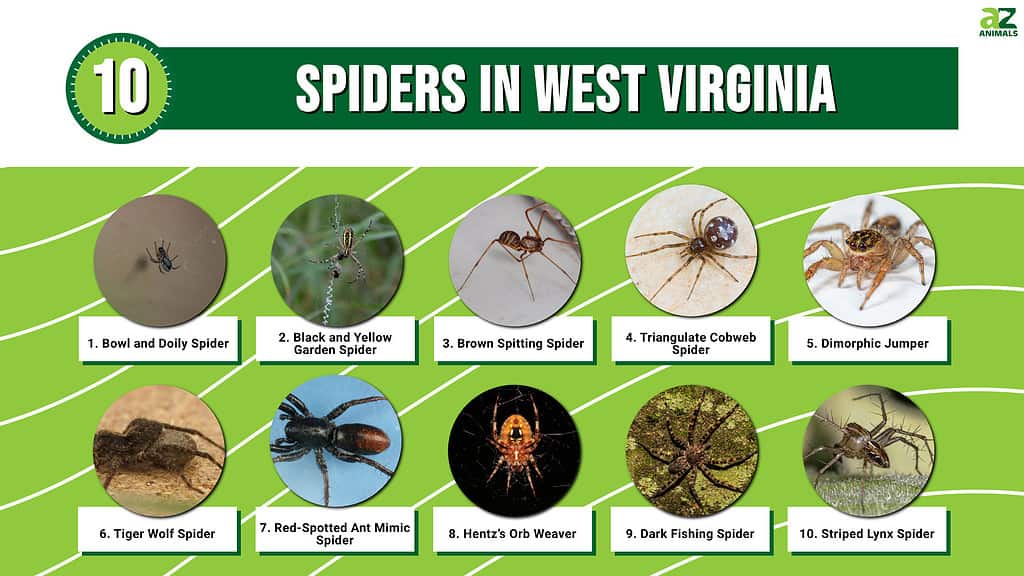
#10. Striped Lynx Spider
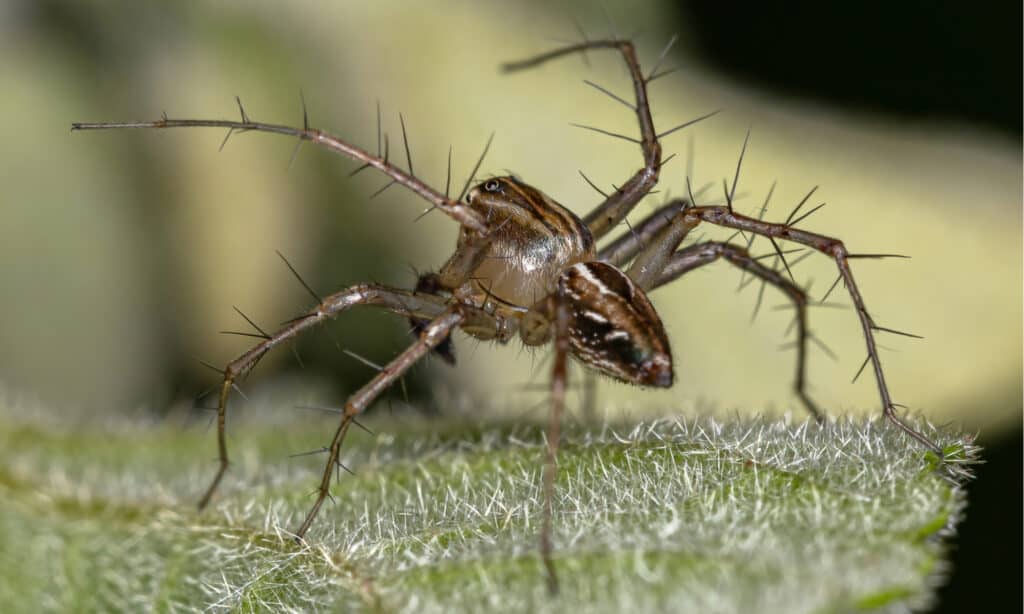
The striped lynx spider actively hunts for prey.
©Vinicius R. Souza/Shutterstock.com
Oxyopes salticus, or the striped lynx spider, is a member of the lynx spider family Oxyopidae. You can find these spiders in West Virginia if you look in leafy vegetation such as grasses, fields, and crops. They also range throughout the eastern United States and Central and South America.
Female striped lynx spiders measure from 5 to 6 millimeters long, while males measure 4 to 5 millimeters long. They come in a range of colors but usually look primarily cream, brown, or orange. That said, females feature several stripes on the abdomen and carapace, which is where they get their name.
Striped lynx spiders actively hunt for prey rather than relying on webs to trap their food. They rank as a major predator of several agricultural pests, so some people consider them beneficial. Due to their small size, their bite is not considered medically significant.
#9. Dark Fishing Spider
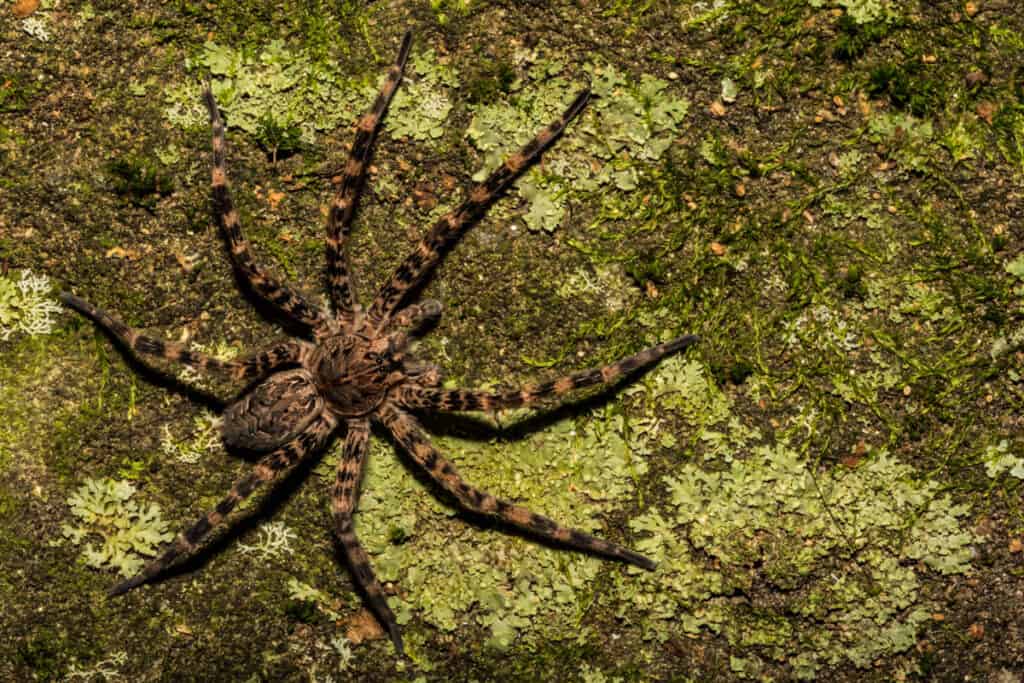
The dark fishing spider can run across the surface of water or dive into the water to catch prey.
©iStock.com/JasonOndreicka
The dark fishing spider, Dolomedes tenebrosus, belongs to the nursery web spider family Pisauridae. It ranges throughout the central and eastern United States as well as parts of Canada.
Dark fishing spiders are one of the largest spiders in West Virginia. Females usually measure between 15 and 26 millimeters long, while males range between 7 and 13 millimeters long. That said, they can measure between 50 and 90 millimeters long with their legs extended. The body looks primarily light brown aside from some characteristic W-shaped markings on the abdomen.
As their name implies, dark fishing spiders hunt by grabbing insects and small fish from the water. They can also dive under the water or run across its surface to catch their prey. Although they can bite, they normally run from people, and their bite is not threatening to humans.
#8. Hentz’s Orb Weaver
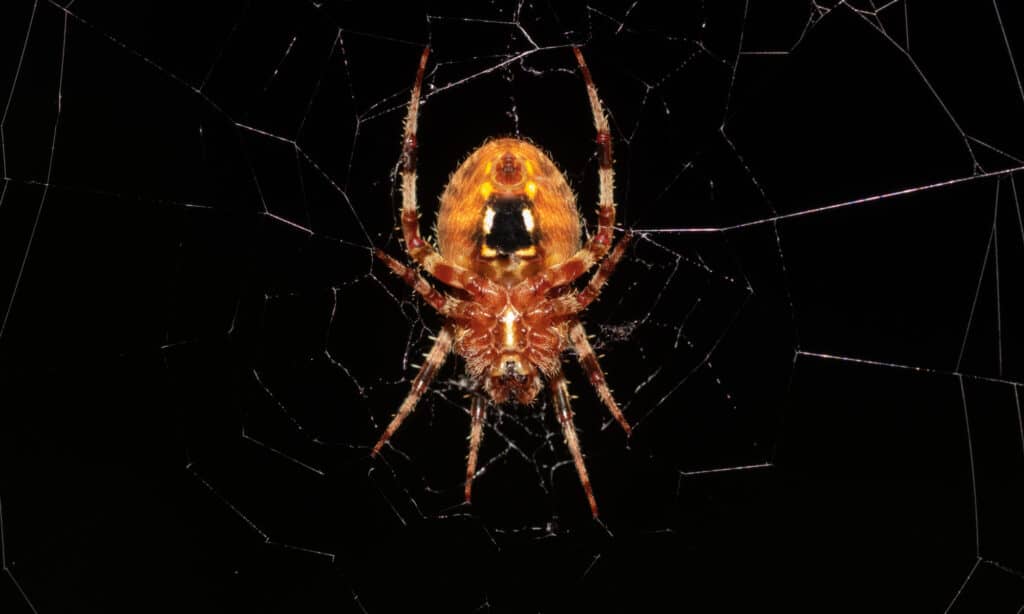
Hentz’s orb-weaver gets its name from the famous arachnologist Nicholas Hentz.
©Christopher Troll/Shutterstock.com
Neoscona crucifera, or Hentz’s orb weaver, is a member of the orb-weaver family Araneidae. It shares its name with the famous arachnologist Nicholas Hentz. However, it also goes by the names the spotted orb weaver and barn spider. You can find these spiders in West Virginia and throughout the United States.
Adult females range from 12 to 18 millimeters long, while males only measure about half as long as females. The abdomen looks brown and is covered in fine hairs. They feature distinctive white dots on the bottom of the abdomen, which is why some people call them spotted orb weavers. Meanwhile, the legs sport alternating light and dark bands.
Hentz’s orb weavers make large, radial-style webs that they use to capture their prey. Females hunt at night but stay awake during the day to repair their webs. They rarely act aggressively, and their bite is not medically significant.
#7. Red-Spotted Ant Mimic Spider
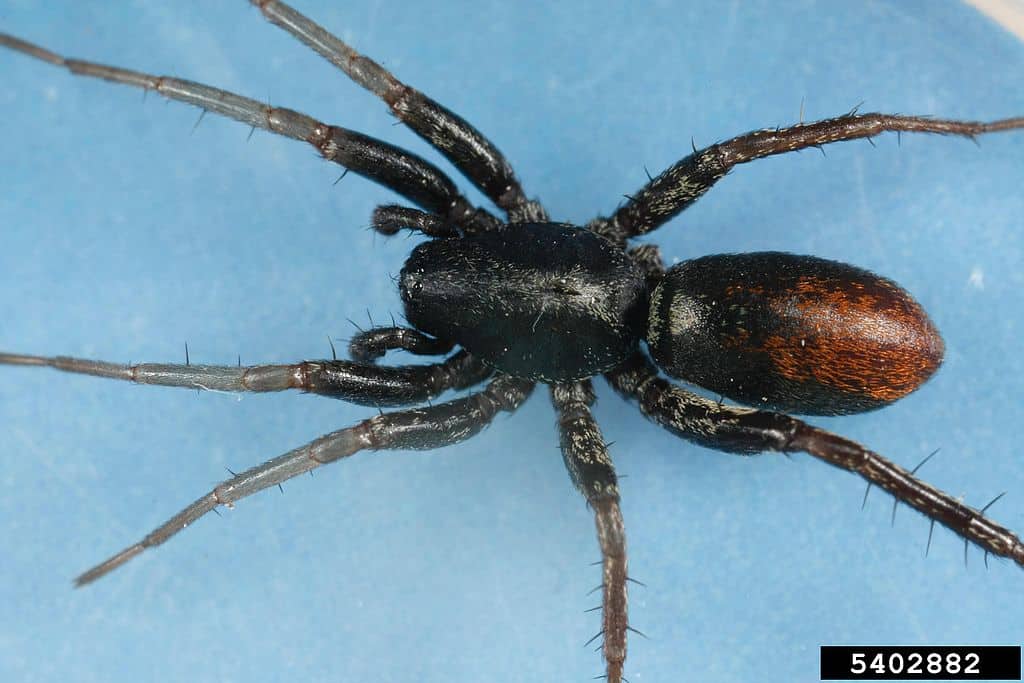
The red-spotted ant mimic acts like an ant in order to sneak up on its prey.
©Joseph Berger, Bugwood.org; University of Georgia / CC BY 3.0, via Wikimedia Commons – License
The red-spotted ant mimic, Castianeria descripta, belongs to the corrinid spider family Corinnidae. You can often find these spiders in shrubs or wooded areas near anthills throughout the United States.
Adult female red-spotted ant mimic spiders typically measure about 13 millimeters long, with males measuring slightly smaller on average. They look primarily black aside from a reddish-brown mark on the abdomen, hence their name. People sometimes mistake them for black widows due to their similar size, shape, and color. However, unlike widows, red-spotted ant mimic spiders feature a white line in the middle of the carapace.
Red-spotted ant mimic spiders use one of the strangest hunting methods of all spiders in West Virginia. Instead of using webs or burrows to trap or ambush prey, they use their front legs as antennae so they can mimic and sneak up on ants. Their bite is not dangerous to humans.
#6. Tiger Wolf Spider
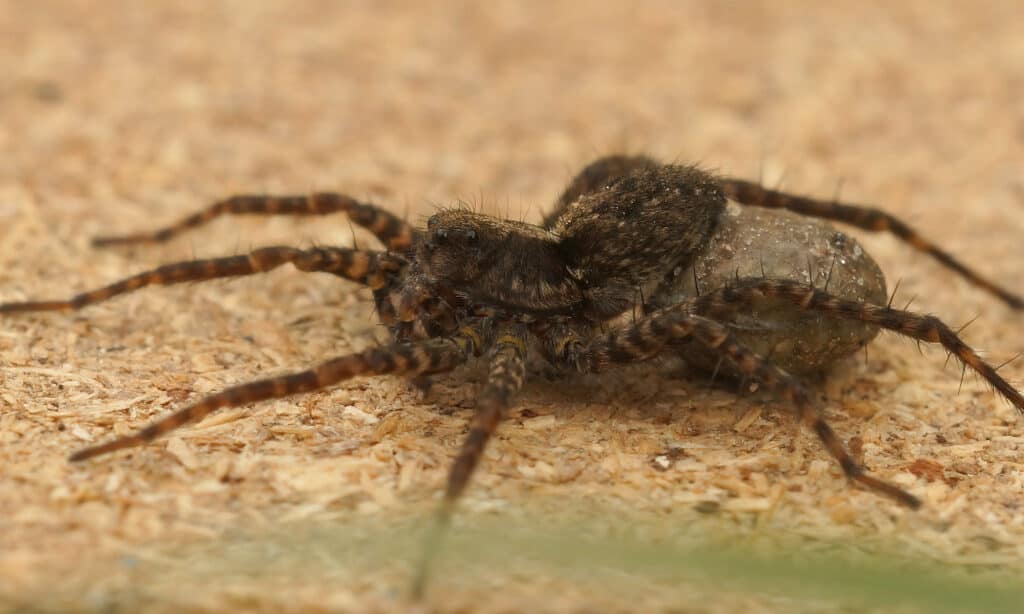
The
tiger
wolf spider is also known as the speckled wolf spider or woodland giant wolf spider.
©HWall/Shutterstock.com
Tigrosa aspersa is more commonly known as the tiger wolf spider. A member of the wolf spider family Lycosidae, you may also know it as the speckled wolf spider or woodland giant wolf spider. It is one of several wolf spiders found throughout West Virginia and much of the eastern United States.
Adult specimens can grow up to 25 millimeters long, with males typically measuring smaller than females. They feature a characteristic narrow yellow line between their eyes. Females look primarily black except for the abdomen, which looks dark grey. On the other hand, males vary in color from beige to tan to light yellow.
Tiger wolf spiders do not use webs to catch their prey. Instead, they actively search for food and rely on their speed and strength to ambush prey. Despite their large size, their bite is not considered medically significant but can be painful.
#5. Dimorphic Jumper

Male dimorphic jumpers come in two different morphs, which is a rare trait in the animal kingdom.
©Justin Starr Photography/Shutterstock.com
The dimorphic jumper, Maevia inclemens, belongs to the jumping spider family Salticidae. It is widely distributed throughout the eastern half of North America.
Adult females vary between 6.5 and 10 millimeters long, while males measure from 5 to 7 millimeters long. Females have a white face and feature two black or red lines down the center of the abdomen. Meanwhile, males come in two different morphs, or varieties, hence their name. One morph sports a grey abdomen with orange markings and white and black stripes, while the other morph looks black with white legs. Dimorphism is rare in the animal kingdom, which makes dimorphic jumpers one of the most unique spiders in West Virginia.
As their name implies, dimorphic jumpers actively hunt for food by leaping onto their prey. Although they are potent hunters, their bite is not threatening to humans.
#4. Triangulate Cobweb Spider

The triangulate cobweb spider makes a messy web that it uses to catch its prey.
©Timelynx/Shutterstock.com
Steatoda triangulosa, or the triangulate cobweb spider, is a member of the cobweb spider family Theridiidae. You may also know it as the triangulate bud spider. It is widely distributed throughout North America, Europe, Russia, and New Zealand.
Female triangulate cobweb spiders range between three and six millimeters long, while males usually measure slightly smaller than females. The legs appear yellow and are covered in tiny hairs. Meanwhile, the cephalothorax looks orangish-brown. A purplish-brown zigzag-shaped marking runs down the center of the abdomen, hence their name.
Triangulate cobweb spiders make messy cobwebs that they use to capture their prey. They use vibrations to tell when prey enters their webs due to their poor eyesight. Their bite is not medically significant, and many people consider them one of the more beneficial spiders in West Virginia because they often prey on more dangerous spiders like brown recluses.
#3. Brown Spitting Spider
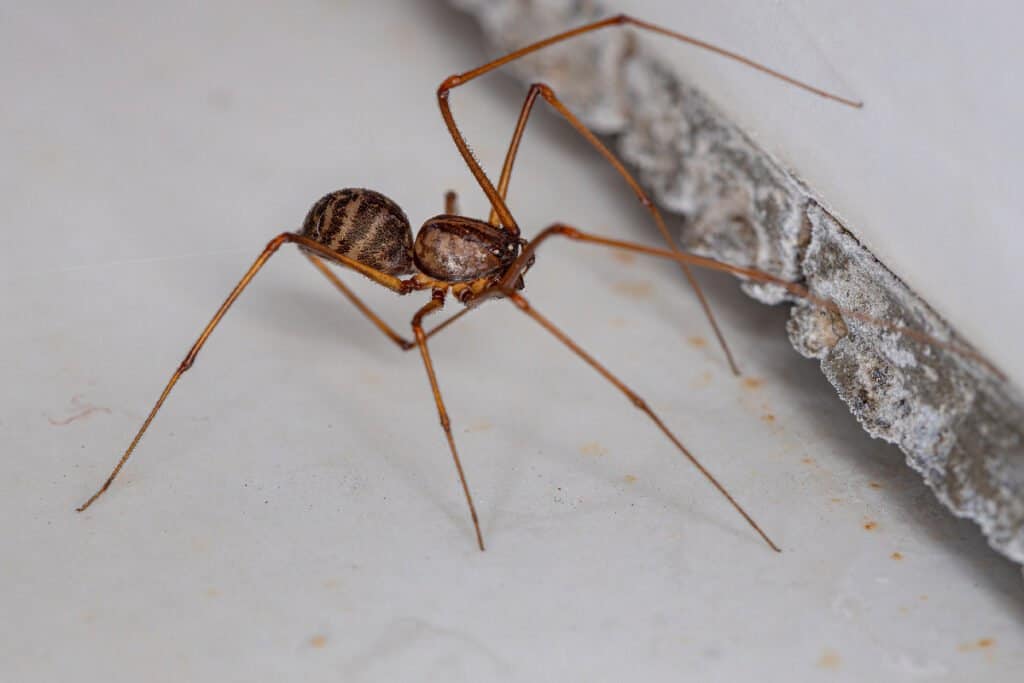
The brown spitting spider catches prey with venomous silk that it shoots from its abdomen.
©iStock.com/ViniSouza128
The brown spitting spider, Scytodes thoracica, belongs to the spitting spider family Scytodidae. You can find these cosmopolitan spiders throughout the world.
Adult brown spitting spiders typically measure between 3 and 6 millimeters long, with females measuring larger than males. Unlike most spiders, they possess six rather than eight eyes. Another unique feature about these spiders is that the abdomen slopes downward while the carapace points noticeably upward. They appear predominantly light brown or tan except for several dark brown markings on the body and legs.
Brown spitting spiders use one of the most unusual prey-capture methods of all spiders in West Virginia. They fire venom-laced silk from up to 10 millimeters away that effectively entangles and immobilizes their prey. Their bite poses little threat to humans due to their small size.
#2. Black and Yellow Garden Spider
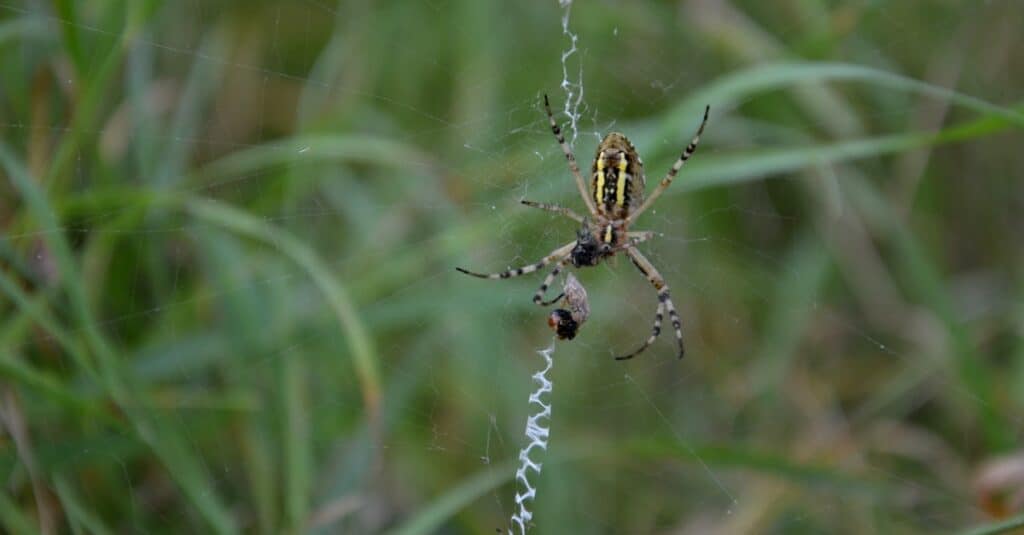
Black and yellow spiders only bite when threatened.
©Beekeepx/Shutterstock.com
Argiope aurantia, or the black and yellow garden spider, is one of the most common spiders in West Virginia. It also goes by the names the writing spider, corn spider, or zigzag spider. A member of the family Araneidae, you can find it from Canada to Costa Rica.
Adult females range between 19 and 28 millimeters long, with males measuring significantly smaller at between 5 to 9 millimeters long. The abdomen features alternating black and yellow stripes. Meanwhile, the carapace looks mostly whitish or silver, and the legs sport black and tan bands.
Black and yellow garden spiders usually spin their webs in fields or under the eaves of houses. These webs can reach up to 2 feet wide and feature a characteristic zigzag pattern. They tend not to bite unless threatened. Their bite can cause a range of mild symptoms, including pain, redness, and swelling.
#1. Bowl and Doily Spider

The bowl and doily spider gets its name from its uniquely shaped web.
©iStock.com/ErikAgar
The bowl and doily spider, Frontinella pyramitela, is a member of the sheet weaver family Linyphiidae. You can find it in alpine and tropical forests throughout North and Central America.
Bowl and doily spiders rank as one of the smallest spiders in West Virginia, with adult specimens measuring only around 4 millimeters long. That said, females typically measure larger than males. They look primarily reddish-brown except for the legs, which appear yellowish. Additionally, they feature white dots on each side of the abdomen.
Bowl and doily spiders make unique webs that they use to catch their prey. The web consists of an inverted dome, or bowl, hung over a horizontal sheet, or doily, which is where they get their name. They hang from the bowl and wait to ambush prey that gets entangled in the non-sticky sheet web below. Their bite is not medically significant due to their small size.
Summary of 10 Spiders in West Virginia
Here’s a recap of 10 spiders present in West Virginia that we took a look at:
| Number | Spider | Scientific Name | Length |
|---|---|---|---|
| 1 | Bowl and Doily Spider | Frontinella pyramitela | 4 mm; females typically are larger than males |
| 2 | Black and Yellow Garden Spider | Argiope aurantia | Females: 19-28 mm; males: 5-9 mm |
| 3 | Brown Spitting Spider | Scytodes thoracica | 3-6 mm; females are larger than males |
| 4 | Triangulate Cobweb Spider | Steatoda triangulosa | Females: 3-6 mm; males usually are slightly smaller |
| 5 | Dimorphic Jumper | Maevia inclemens | Females: 6.5-10 mm; males: 5-7 mm |
| 6 | Tiger Wolf Spider | Tigrosa aspersa | 25 mm; males are typically smaller than females |
| 7 | Red-Spotted Ant Mimic Spider | Castianeria descripta | Females: 13 mm; males are slightly smaller |
| 8 | Hentz’s Orb Weaver | Neoscona crucifera | Females: 12-18 mm; males measure about half as long as females |
| 9 | Dark Fishing Spider | Dolomedes tenebrosus | Females: 15-26 mm; males: 7-13 mm. Can be 50-90 mm long with their legs extended. |
| 10 | Striped Lynx Spider | Oxyopes salticus | Females: 5-6 mm; males: 4-5 mm |
The photo featured at the top of this post is © iStock.com/DianaLynne
Thank you for reading! Have some feedback for us? Contact the AZ Animals editorial team.






